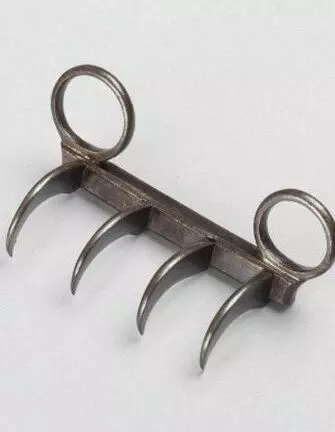Shivaji’s wagh nakh brought from London: Genuine artefact or replica?
Historians have claimed the wagh nakh used to kill Afzal Khan was in the State’s Satara district itself
By Kedar Nadella
Hyderabad: In July, the Maharashtra government brought a significant part of the State’s history wagh nakh to India on a three-year loan from the Victoria and Albert Museum in London.
The wagh nakh are said to be the tiger claws worn by the Maratha Empire founder Chhatrapati Shivaji Maharaj to kill Bijapur Sultanate general Afzal Khan in 1659. It is a hugely revered episode among followers of the legendary warrior-king.
However, some historians have claimed the wagh nakh used to kill Afzal Khan was in the State’s Satara district itself, and the one bought from London on loan is a replica. The State government has refuted the claims.
The wagh nakh brought from London as part of an agreement signed by the State government was put on for public display from July 19 at the Chhatrapati Shivaji Sangrahalay in Satara.
What is the history of wagh nakh?
Wagh Nakh, a weapon for close combat fighting, is said to have been used by the Maratha king to kill Afzal Khan, the general in the Bijapur Adil Shahi empire. It is a dagger designed in the shape of a tiger claw.
According to the details about the artefact on the Victoria and Albert (V&A) Museum website, the British got the relic when it was given to James Grant-Duff of Eden when he was a resident at Satara by the prime minister of the Peshwa of the Marathas, sometime before 1823.
The fight between Chhatrapati Shivaji and Afzal Khan is also mentioned in detail. The records stated that both arranged a truce and met in a tented enclosure, but both came armed; Shivaji wore metal protection under his clothes including in his turban. He held a metal ‘tiger claws’ weapon concealed in his hand.
When a fight broke out, it ended when ‘Shivaji disembowelled’ Afzal Khan with the wagh ankh.
However, the museum also said that it is not possible to determine whether the one with them is the same tiger claw used by Shivaji.
The London Museum told NewsMeter their records hold no information that confirms what James Grant Duff was told when he was given the Tiger Claws, and as the events that occurred between Chhatrapati Shivaji Maharaj and Afzal Khan took place over 150 years before Grant took ownership of them, it hasn’t been possible to verify the provenance. It is possible that the tiger claw might have been ‘gifted’ to Grant Duff after the last Peshwa of the Marathas, Bahi Rao II surrendered to the British in June 1818 after the defeat in the Third Anglo-Maratha War and was banished to Bithoor near Kanpur.
The museum stated that a fitted case was made for the weapon after Grant Duff returned to Scotland in 1823. The inscription on the case reads: “The ‘Wagnuck’ of SivajeeWith Which He Killed the Moghul General. This Relic was given to Mr. JamesGrant-Duff of Eden When he was Resident at Sattara By the Prime Minister of the Peishwa of the Mahrattas”.
The museum said that debates on the historical accuracy of the relics it houses are not rare. “The V&A collection has 2.8 million items, spanning 5,000 years of creativity so it’s not unusual for there to be gaps in the information we hold about an object’s history,” the museum stated.
Replica, alleges historian
But after the relic was brought to the country, many have come out stating that it is a replica. Historian Indrajit Sawant was one of the opposition voices to the government’s claims.
In a press conference on July 8, Indrajit Sawant showed documents from V&A that he claimed proved that the wagh nakh brought from London was not original.
“It is being said that the tiger claws were given to the British by Pratap Singh Maharaj. And how could a man like Pratap Singh Maharaj, who is a Shiva bhakt, give the tiger claw?” Indrajit Sawant asked. Moreover, there are records that even after the tiger claws are said to have left India, it was reportedly seen by many in India. How is that possible, he asked.
What are the contents of the letter?
According to the document displayed by Indrajit, the V&A museum said that as per their records, the tiger claw came to the museum on October 28, 1971. The museum said that they have been open about claiming that there is confusion about whether the tiger claws they have really belonged to Shivaji, and they expected the government to also mention the same when they keep it for display.
Indrajit’s claims were refuted by state culture minister Sudhir Mungantiwar and others. “It is unfortunate that doubts are being raised about Shivaji’s wagh nakh,” Mungantiwar told PTI and asserted that the tiger claws bought from the London Museum are the real ones.
He said that the same wagh nakh were on display between 1875 and 1896 before being given to the Victoria and Albert Museum.
He also rejected the claim that the government spent crores of rupees to bring the relic from London to Maharashtra. He said the travel expenses and signing of the agreement cost Rs 14.08 lakhs.
With inputs from PTI